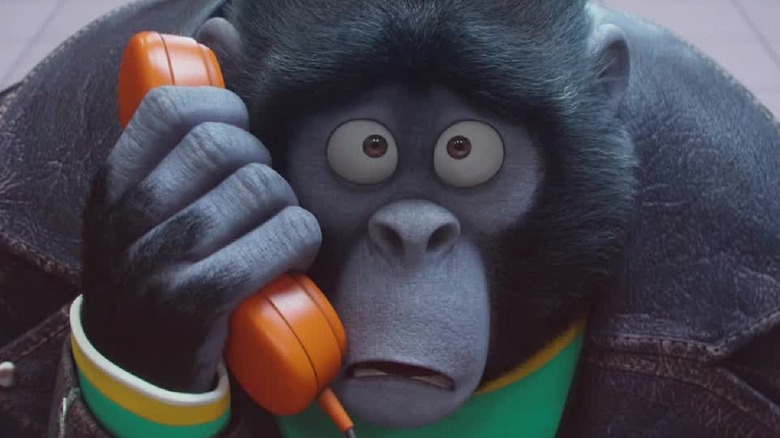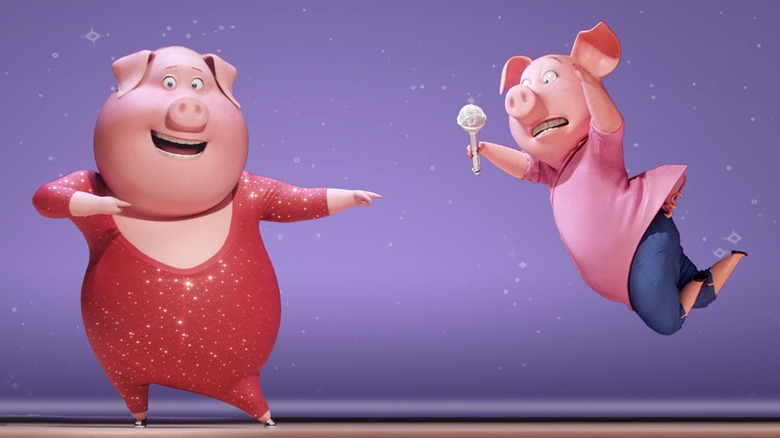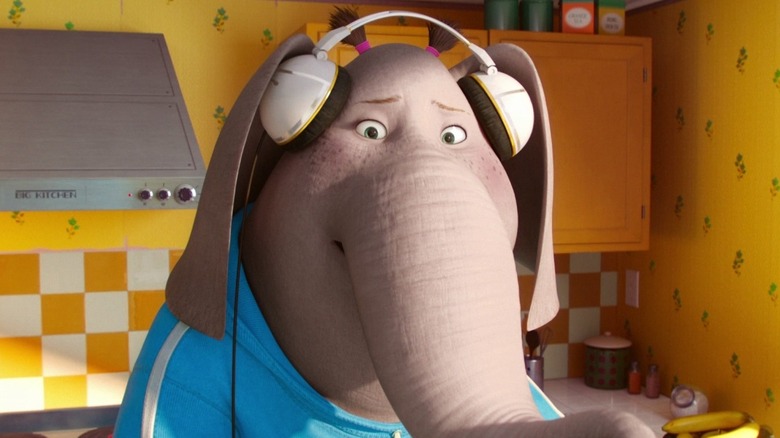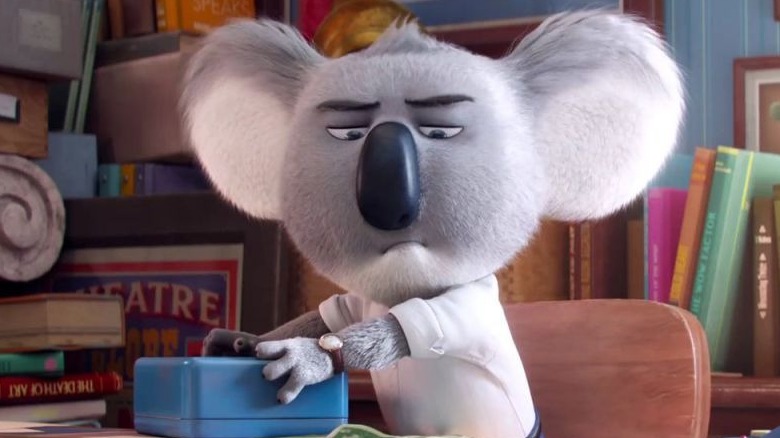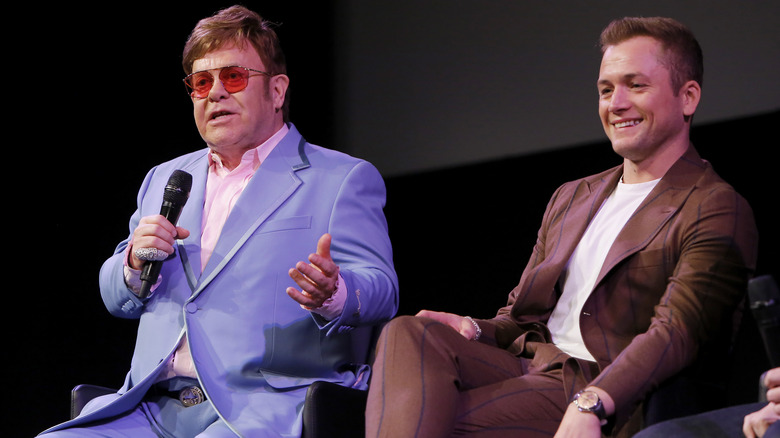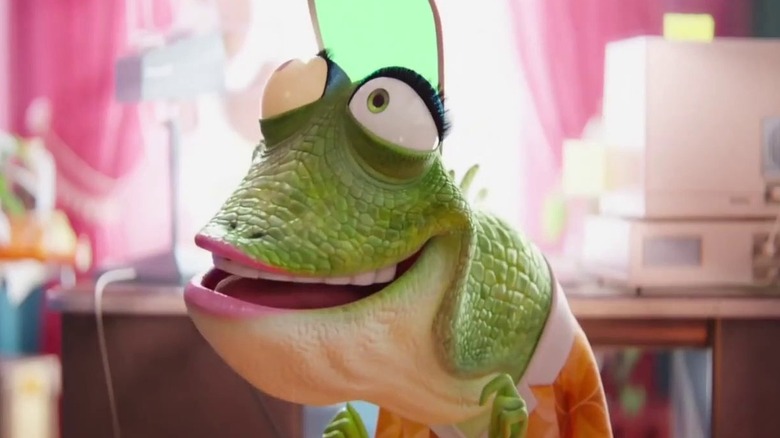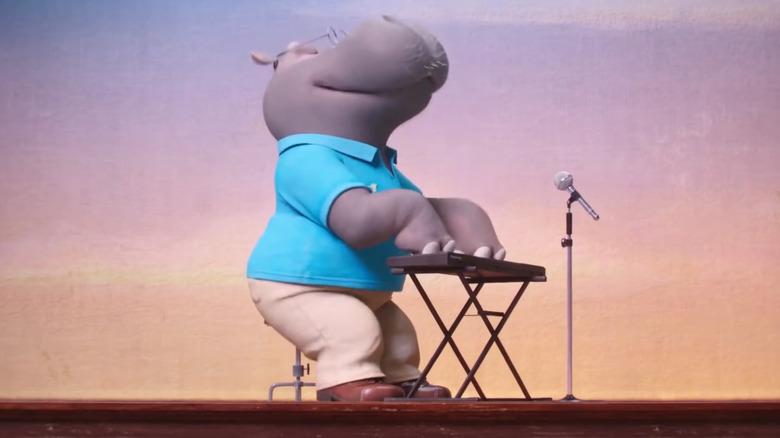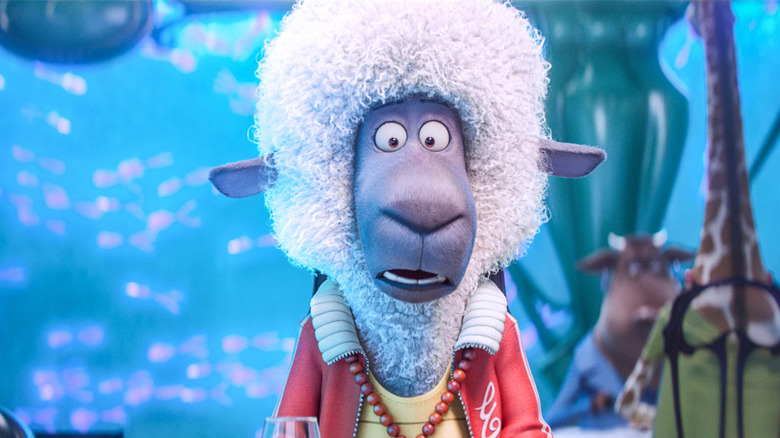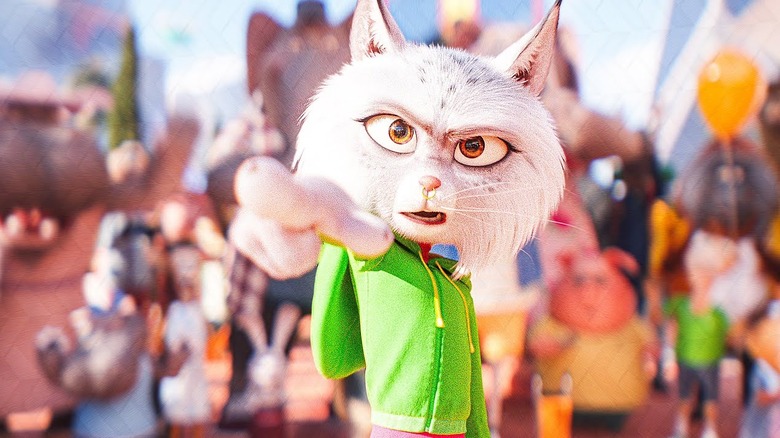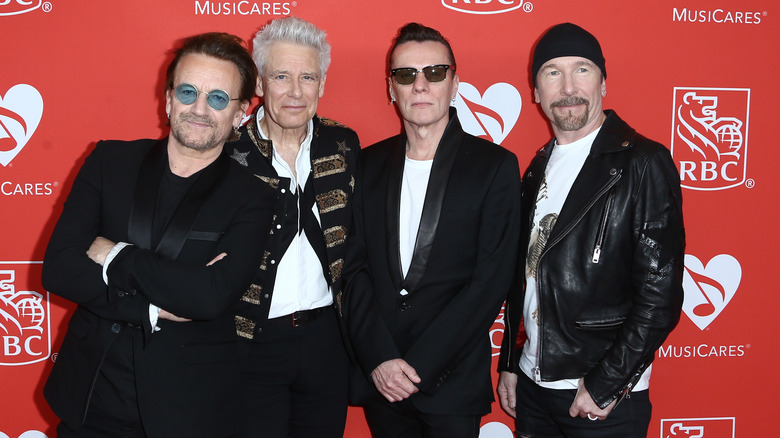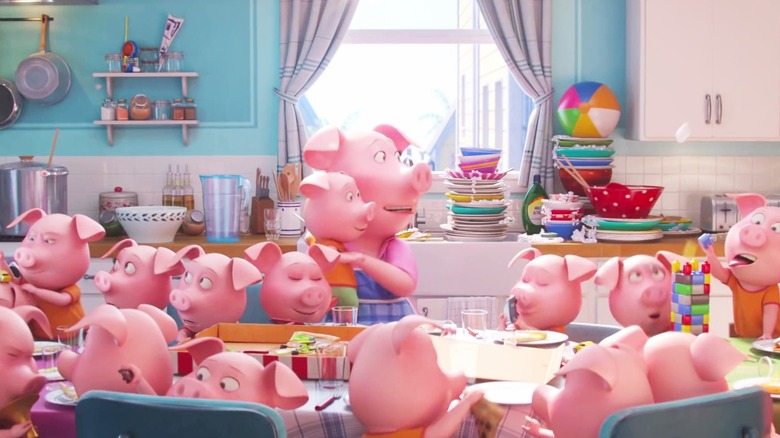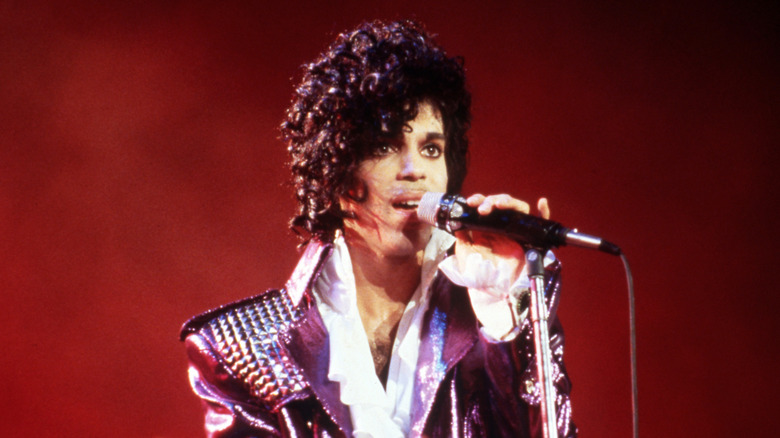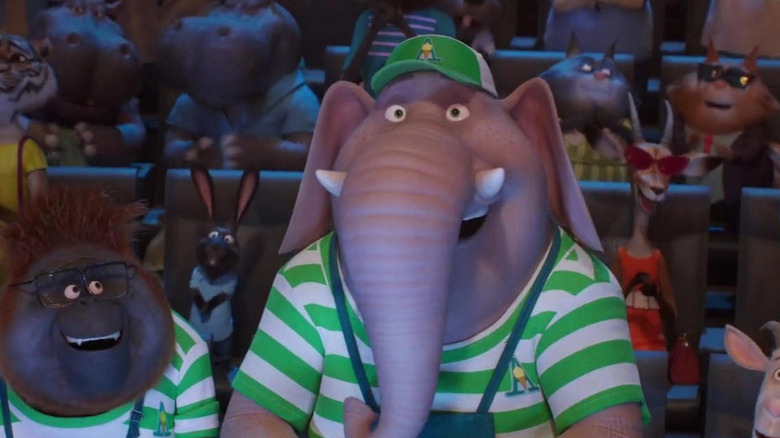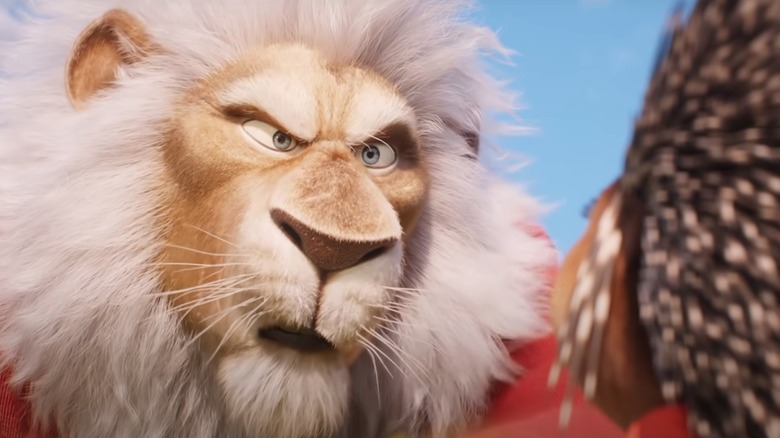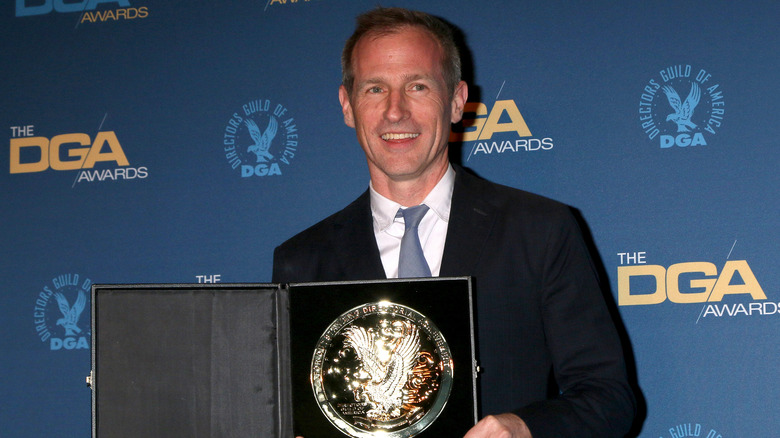The Untold Truth Of The Sing Franchise
While nothing compares to Illumination's "Despicable Me/Minions" franchise, their "Sing" series is a definite contender for runner-up. Across two full-length movies and several shorts thus far, "Sing" takes place in a world consisting entirely of anthropomorphic animals and follows a few who are looking to become famous in the world of music and theater.
With an all-star cast that includes Matthew McConaughey, Reese Witherspoon, John C. Reilly, Scarlett Johansson, Taron Egerton, and many more, both movies are packed with hit songs and a handful of originals. Using current pop songs and hits that date back decades helps ensure these movies connect with audiences of multiple generations. A character might be singing a Billie Eilish number one minute and a Frank Sinatra standard the next. All of this — coupled with funny characters and feel-good stories — helps the "Sing" movies rise above many of their peers.
But what went into the making of these movies? How were the songs chosen, and how much did they cost to license? How did one movie manage to score both a U2 original and have an entire musical number featuring a Prince song? Read on for the answers to these questions, plus many more fascinating tidbits about the "Sing" series.
Sing was in development for a while
Animated movies generally take a long time to make, and computer animated ones are no different. In particular, the first entry of a computer animated series takes the longest because all of those characters and the worlds they inhabit are being built from the ground up for the first time. And this is to say nothing of the early stages of development, where a film is still being conceptualized and written.
In the case of "Sing," writer/director Garth Jennings had never made an animated film before, which further delayed the process. As he explained to Insider, he started out by writing it the way he wrote his previous live-action films ("Son of Rambow" and "The Hitchhiker's Guide to the Galaxy"). It was then handed over to Illumination's Chris Meledandri, who had to then reshape the script and the ideas into something more suitable to an animated movie. Between that and having to take a lot of time trying to get all the characters hammered out — plus then actually making the movie — the journey of "Sing" from concept to release ended up being a period of a little over five years.
How much did it cost to get all that music?
The "Sing" movies do not skimp on the music. Almost every song is a huge, chart-topping hit by a major recording artist, and barely a few minutes go by in either film before another massive tune is sung by one of the characters or just starts playing in the background. It certainly couldn't have been cheap to pay for all of that music — and in terms of the first "Sing" movie alone, that price tag was extremely high.
The original movie had a whopping 65 songs in it, which producer Chris Meledandri says cost the studio nearly $12 million in licensing fees (per The Hollywood Reporter). That's 15% of the film's entire production budget, which is nothing to sneeze at. But considering the movie would go on to gross $634 million worldwide, that $12 million ended up being a drop in the bucket and was money well spent.
Buster Moon was originally a lot different
At the center of the "Sing" universe is Buster Moon, a theater owner who has big dreams and isn't afraid to embroil himself in not-always-above-board schemes to accomplish his goals. Still, while he can stretch the limits of honesty and morality a bit from time to time, he's never slimy and never comes off as a mean-spirted shyster. It's a good thing, too, because it can be hard to root for a character like that, especially in a movie series for kids.
However, when Buster's character was still being developed, he was indeed a much shadier and less lovable character. "He did start off on paper being a little more of a charlatan," Garth Jennings explained to Insider. "There's a fine line dealing with a character like that where they are kind of con people a bit. Chris [Meledandri] and I found early on that he became a bit too unlikable because we were pushing that button too much. He was being a little too rude. And his likability went down for us."
It was eventually decided that a character like that wasn't a great fit to be the main protagonist of a feel-good family film, so Buster was retooled and softened up significantly. The end result is a koala who might look for shortcuts that aren't always "right," but his heart is always in the right place, and he's always looking out for the best interest of the people he cares about.
Sing was like Taron Egerton's audition for Rocketman
By now, Taron Egerton has more than established his singing abilities on top of his acting abilities. However, when he first appeared in the original "Sing" as a gorilla named Johnny, it was most people's first exposure to his formidable vocal prowess. In fact, one of the most memorable moments in the original trailers for "Sing" was Johnny belted out an impressive rendition of the Elton John classic "I'm Still Standing," and it turns out that it wasn't just the moviegoing public that took notice.
During an Apple Music interview with Egerton and John, the veteran rock star said that he was immediately blown away with Egerton's rendition of the song. In fact, he was so impressed that after hearing it, he had no doubt in his mind that not only could Egerton play him in the biopic "Rocketman" but that Egerton could sing all of the songs himself — something that doesn't always happen in biopics (see "Bohemian Rhapsody"). John would also share the screen with Egerton when the singer made a rare acting appearance in 2017's "Kingsman: The Golden Circle."
The story behind Miss Crawly's voice
When writing a movie, it can be tricky to really nail down a character's personality, mannerisms, and overall vibe. With animated movies, this is especially important to get straightened out during the writing and planning stages, as it goes on to inform how the artists end up designing and animating the character. As such, Garth Jennings — writer and director of both "Sing" films — recorded what are known as "scratch" voices for the characters' dialogue, to help him better develop them and also to give the art team an idea of how the characters should look and move.
While most of the characters ended up finding the perfect voice actors to take over and bring the roles to life, Jennings' own rendition of the quirky Miss Crawly ended up sticking. As he told Deadline, his reading of Miss Crawly just ended up feeling right, and he wound up playing her himself. Of course, there's an established tradition of a filmmaker playing an offbeat, scene-stealing character in their own animated film — most notably, writer/director Brad Bird playing the voice of fashion designer Edna Mode in both "Incredibles" movies.
Why this obscure jazz song was used in Sing
While most of the songs from the "Sing" franchise will be well-known to a good chunk of the viewing audience, there are a few that people might've heard for the first time while watching the films — and we aren't just talking about the original songs. Director Garth Jennings was a huge fan of a song called "Stout-Hearted Men," specifically the version song by a lesser-known jazz musician known as Shooby Taylor. So he decided to include that number in the first "Sing" movie, not only because he liked it but also for a very noble reason.
Per the "Adam and Joe" show, Jennings had heard that Taylor's son — Taylor himself passed away in 2003 — was struggling to make ends meet. So Jennings thought that by including "Stout-Hearted Men" in the movie, Taylor's son and family could make a little money off of the royalties the song would earn from being in the film. It was an incredibly kind gesture, as well as helping to tell the world about Shooby Taylor himself — an underrated artist with an extremely unique style of scatting.
Sing broke a record previously held by My Big Fat Greek Wedding
Both of the "Sing" movies were undeniable box office successes and made a good chunk of cash for Illumination and Universal Pictures, but the first movie holds a unique record in regard to its earnings. It's the current record holder for the movie that made the most money at the domestic box office without spending a single week at the #1 spot in its entire theatrical run.
The previous owner of that unique distinction was "My Big Fat Greek Wedding," which held claim to that record for an impressive 14 years before "Sing" overtook it in 2016. Interestingly, it's a distinction that isn't terribly uncommon among kids movies, as the third- and fourth-place movies on the list are "Alvin and the Chipmunks" and its sequel. In addition, "Sing 2" also never made it to #1, but it still managed to bring in an impressive $162.7 million domestically anyway (per Box Office Mojo).
The Sing franchise features several first-time voice actors
The "Sing" movies have gathered some extremely impressive talent to voice its characters — we're talking a roster of A-listers, as well as multiple Oscar nominees and winners. Among those who were no strangers to animated voice work prior to this series are Matthew McConaughey, Scarlett Johansson, John C. Reilly, Reese Witherspoon, Seth McFarlane, Nick Kroll, Jennifer Saunders, Nick Offerman, Leslie Jones, and Eric Andre.
However, the franchise also managed to bring a few actors in who'd never previously voiced a character in an animated film before. Not only was it Taron Egerton's first time doing such work, but Letitia Wright and Chelsea Peretti were both new to animated films when they appeared in "Sing 2," although Peretti had experience in animated TV shows like "Big Mouth." Additionally, musicians Tori Kelly and Bono had never voiced an animated character in a feature-length film before they showed up in the "Sing" franchise, but they could've fooled us as they're both pretty terrific.
Bono had to convince the rest of U2 to allow their music in Sing 2
Much of "Sing 2" revolves around Buster Moon and company trying to get a musician named Clay Calloway to allow the use of his songs in their play — and to appear in the play himself. The problem? Calloway had been a recluse for years, and even so much as contacting him is going to be difficult. While the reveal of who voices the lion character might've been meant to be a surprise, the fact that Calloway's music just happens to be U2 songs in real life is a pretty big clue.
Yes, U2 frontman Bono voices Calloway in "Sing 2," and the movie not only features several classic U2 songs but also a brand new track called "Your Song Saved My Life" written by the band specifically for the film. Bono claims (via the Los Angeles Times) that he was excited about the project from the start, but his bandmates needed some convincing to allow their music in the movie and to also do a new song for it. He says that he played them a recording of Scarlett Johansson singing a version of their song "Stuck in a Moment You Can't Get Out Of," and that was the last bit of pushing they needed to be convinced that their work was in good hands.
Who voices the piglets?
A common source of comic relief in both "Sing" movies are the many, many piglets of Rosita and Norman — and in "Sing 2" in particular, these little kids end up playing a very important role in helping the other characters successfully pull of the climax of the film. As an extra bit of fun, four of the piglets are voiced by the children of director Garth Jennings — Oscar, Leo, Caspar, and Asa.
Getting the real-life children of members of the production doesn't stop there, though. Per People, in "Sing 2," Matthew McConaughey's daughter Vida also plays one of the piglets. She even gets to deliver a particularly memorable line, saying "this is the best day of my life" while swimming in a fountain full of chocolate. Vida said a few more lines as well, but it's cool that she got to deliver such a fun punchline.
The official Prince Twitter account helped promote Sing 2
While he was alive, Prince was notoriously picky about how his music was used and licensed. "Weird Al" Yankovic told Billboard that Prince turned him down four different times when asked to parody one of his songs, and Prince was one of only a handful of musicians that refused to allow his music to appear in video games like "Guitar Hero" (per Gamespot). Needless to say, if you heard a Prince song in a movie or TV show, it was something special indeed.
That said, since his passing, his estate has been much more generous about licensing his music. While it may sound like greed on the surface, they claim that it's an effort to expose his music to younger generations and to help it live on well beyond Prince himself. One such example of this was letting Illumination use "Let's Go Crazy" as the big opening number for "Sing 2," and his estate even went as far as to promote the movie and its use of the song on Prince's official Twitter account.
Pharrell Williams finally joined the Illumination universe as Alfonso
In addition to all of the work he's done as a solo artist, producer, songwriter, and a member of the group N*E*R*D, Pharrell Williams also has a longstanding creative relationship with the animation studio Illumination. He's helped compose music for all three "Despicable Me" movies, and he's provided several original songs for the franchise. He even waded into acting a bit by narrating the studio's 2018 adaptation of "The Grinch," where he got to deliver some of the most iconic lines in pop culture history.
However, Williams has done very little actual acting — so it's something of a big deal that he plays an actual on-screen character in "Sing 2." In the movie, Williams plays Alfonso, an elephant who becomes the object of Meena's affection and does an (imaginary) duet with her near the end of the film. After years of working with Illumination behind the scenes, it was fun to see him get a role in one of their films — and a pretty sizable and important one, at that.
Clay Calloway was voiced by other musicians in different countries
It was clearly important for Clay Calloway to be played by a real-life musician and pop music legend, and few living singers encapsulate that as much as U2's Bono. However, U2 isn't necessarily as big in other parts of the world as he is in the United States or Europe, so it wouldn't necessarily have the same impact for moviegoers in countries that aren't as familiar with him to hear the Irish star show up in the film. Plus, as far as we know, Bono doesn't speak every language needed to translate the movie all over the world.
With that in mind, for at least the Latin American and Japanese dubs of the film, famous musicians more tailored to those regions were chosen to dub Clay Calloway's dialogue. In Latin America, he was played by Chayanne, a huge Puerto Rican pop star. In Japan, he was voiced by Koshi Inaba, a member of the hugely popular Japanese rock duo B'z.
Multiple filmmakers play characters throughout the Sing series
In addition to characters voiced by actors and musicians, the "Sing" movies also enlisted several famous filmmakers to play various characters. For example, as pointed out by Collider, Edgar Wright ("Shaun of the Dead," "Last Night in Soho") voices a police dog and a driving pig, while Wes Anderson ("The Grand Budapest Hotel," "The French Dispatch") loans his voice to a particular type of primate known as a tarsier. Even "Despicable Me" director Chris Renaud shows up at one point.
Interestingly, "Sing 2" got another filmmaker on board, but this one was uncredited. Per The Hollywood Reporter, Garth Jennings introduced writer/director Spike Jonze ("Her," "Being John Malkovich") during a press event for the film and revealed that Jonze played the role of Jerry, the assistant to the movie's main protagonist, Mr. Crystal. Of course, Jonze is no stranger to appearing on-screen, most notably in his various appearances throughout the "Jackass" franchise.
